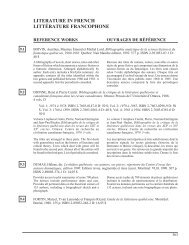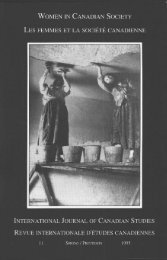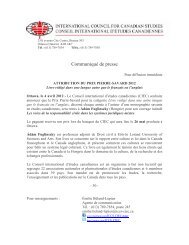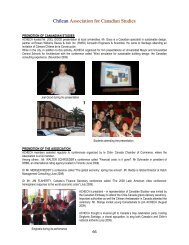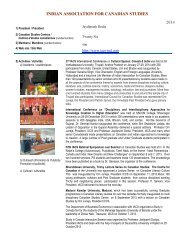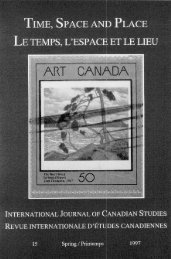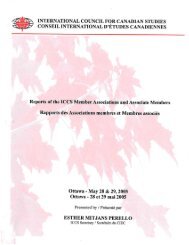Arts and Literature in Canada:Views from Abroad, Les arts et la ...
Arts and Literature in Canada:Views from Abroad, Les arts et la ...
Arts and Literature in Canada:Views from Abroad, Les arts et la ...
- No tags were found...
You also want an ePaper? Increase the reach of your titles
YUMPU automatically turns print PDFs into web optimized ePapers that Google loves.
The Jordans. Remembered <strong>and</strong> Invented Pastsee them as extensions of themselves. “You’re so much like me, if only youknew!” Whenever Charlotte Jordan says this, Nelly feels an urgent need toprotest. Y<strong>et</strong>, grow<strong>in</strong>g older, she “catches herself at imitations she would neverhave thought possible” (MC 90).“I did not want to be like my mother” (LG 150), says Del, resent<strong>in</strong>g AdaJordan’s “stubborn hopefulness” when project<strong>in</strong>g her own unfulfilled hopes<strong>in</strong>to Del’s future:“There is a change com<strong>in</strong>g <strong>in</strong> the lives of girls <strong>and</strong> women. Yes. But itis up to us to make it come. All women have had up till now has beentheir connection with men [...]. No more lives of their own, really,than domestic animals [...]”. (LG 146 f.)But Del, who cannot bear to hear her mother express her dissatisfaction withher own life, is “s<strong>et</strong> up to resist” her mother’s advice. She decides “to go out[like men] <strong>and</strong> take on all k<strong>in</strong>ds of experiences <strong>and</strong> shuck off what [she] didn’twant <strong>and</strong> come back proud” (LG 147). And y<strong>et</strong>, no less acutely than Nelly, sheis aware of the <strong>et</strong>ernal problem of daughters, namely that of be<strong>in</strong>g torn b<strong>et</strong>weenthe mother image which they have <strong>in</strong>ternalized <strong>and</strong> their need to develop <strong>and</strong>assert their own <strong>in</strong>dividual identity: “I myself was not so different <strong>from</strong> mymother, but concealed it, know<strong>in</strong>g what dangers there were” (LG 68).Nelly <strong>and</strong> Del decide to shape their own lives, to work to atta<strong>in</strong> a physical <strong>and</strong>emotional <strong>in</strong>dependence their mothers have striven for <strong>in</strong> va<strong>in</strong>. John Moss’judgement on Ada Jordan also applies <strong>in</strong> the case of Charlotte Jordan: “She istoo conditioned by the values she rejects to successfully rise above them.” 18Attempt<strong>in</strong>g to shape their daughters’ imag<strong>in</strong>ations, both mothers refer toexemp<strong>la</strong>ry exponents of male ideology with<strong>in</strong> their respective nationalliteratures, namely, to Tennyson <strong>and</strong> Schiller. (For tell<strong>in</strong>g examples, see LG146 f. <strong>and</strong> MC 93.) Like Ada Jordan, Charlotte Jordan “knows her po<strong>et</strong>ry (MC93). Like Nelly, Del feels an irresistible impulse to resist anyth<strong>in</strong>g [mother]told me with such earnestness, such stubborn hopefulness” (LG 147). Both“artist-daughters” transform the <strong>in</strong>escapable body of the mother <strong>in</strong>to a po<strong>et</strong>iccorpus generat<strong>in</strong>g both acceptance <strong>and</strong> rejection “of a <strong>la</strong>nguage to be learned.”The message transcend<strong>in</strong>g the boundaries of fiction is obvious: if the twomothers are valid examples of our century’s first generation of women, theirdaughters are c<strong>la</strong>ssic representatives of its second generation. As emerg<strong>in</strong>gwriters, they are s<strong>et</strong> on transform<strong>in</strong>g the raw material of their lives <strong>in</strong>to art: bothfirst-person narrators use the mother-daughter conflict as a po<strong>in</strong>t of departure<strong>in</strong> the search for their own identity, as women <strong>and</strong> artists alike: they aredaughters “who will have a room of [their] own” (MC 35).For Nelly <strong>and</strong> Del, break<strong>in</strong>g the boundaries of the maternal territory impliesapproach<strong>in</strong>g the territory of men, tentatively try<strong>in</strong>g to f<strong>in</strong>d out what sex is al<strong>la</strong>bout. Hav<strong>in</strong>g been sheltered by their prudish <strong>and</strong> protective mothers far <strong>in</strong>toadolescence, both girls have their first visual experience of sex when73



